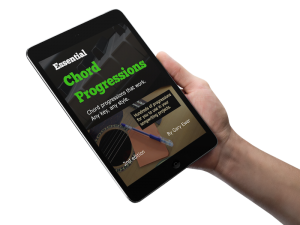You may not think of many of the early Beatles songs as using complex or unusual chord progressions, but for their day, they were noticeably creative. Where so many other early- to mid-era rock and roll songs were barely straying beyond the basic I-IV-V-I kinds of progressions, The Beatles were throwing in modal mixtures, secondary dominants and other imaginative chords.
 If you like the chords-first songwriting process, you’ll want to be sure to avoid some common problems that can arise. “Writing a Song From a Chord Progression” shows you how to make the most of the chords-first method of songwriting.
If you like the chords-first songwriting process, you’ll want to be sure to avoid some common problems that can arise. “Writing a Song From a Chord Progression” shows you how to make the most of the chords-first method of songwriting.
These days, you really can’t easily come up with a progression that hasn’t been done before. So one easy way to find progressions that are more inventive and imaginative is to simply find the songs you like that stray beyond basic chords, and then use what you hear, or modify them for your own use.
But if you’re the creative sort (you are a songwriter, after all!) you can create your own more complex progressions if you start simple.
Starting simple has a very important advantage: no matter how complex a chord progression eventually becomes, it’s usually the case that the tonic chord is still the target.
The problem that many songwriters find themselves in is that as they work out a more complex progression, that targeting of the tonic chord gets abandoned, and the progression starts to sound like aimless wandering — a confusing mess, to be honest.
Some Simple Changes
If you start simple and then make that simple progression more complex, you have the important advantage of having the tonic chord still sounding like an important target. Let’s use a simple example to show what I mean.
I-IV-V-I
C-F-G-C
C is the tonic chord, and as you can see, it starts and finishes the progression. Listeners hear that easily, even if they don’t have the musical vocabulary to describe it.
Now let’s take that simple progression and see what we can do with it. Most of the changes and additions you make to a simple progression like this can come from some basic improvising and experimenting. So playing around with that progression can give you these alternatives:
I-ii-V-I
C-Dm-G-C
(Change the IV-chord to a ii-chord)
I-IV-V-vi
C-F-G-Am
(Change the final C chord to a “deceptive cadence” on a vi-chord)
I-vi-V-iii
C-Am-G-Em
(Change IV to vi, then change the final I-chord to a iii-chord)
As you can see, these are easy changes to make. It might mean that you’ll have to change some melody notes if you’ve already come up with a tune, but in any event, this is the easiest way to come up with something a bit more creative.
Making Longer Progressions
Often, making something more complex means making the progression longer. The idea is to keep the chords that you have already, but insert more complex chords. The advantage here is that since the smaller progression targets the tonic chord, inserting more chords in the midst of it should result in a new, more complex progression that still targets the tonic.
I-IV-V7/V-V-I
C-F-D7-G-C
(Throw in a secondary dominant 7th chords: D7)
I-IV-Bb-IV-V-vi
C-F-Bb-F-G-Am
(Insert a flat-VII after the IV, and end the progression on a vi-chord)
vi-IV-ii-bIII-bVII-IV-V-vi
Am-F-Dm-Eb-Bb-F-G-Am
(Now making use of flat-III as well)
As your progression becomes more complex, remember that having root movement of 4ths or 5ths (i.e., the bass note moves 4 notes higher or 5 notes lower) really does a lot to solidify the sound of a progression.
In that progression above, you see this kind of bass movement in the added chords, and it keeps things from flying apart: bIII to bVII, bVII to IV
So if, as you make your progression longer, you find that things are starting to sound confusing, look at the bass line you’re creating, and try to find a way to add a chord that allows the bass to move by 4ths or 5ths.
In the end, it’s your ears that will tell you if it’s all working. Trust what you hear. If you like it, you don’t need a theoretical reason for it working. Sounding good usually means that the theory is solid, even if you’re not sure why it’s working.
 Written by Gary Ewer. Follow Gary on Twitter.
Written by Gary Ewer. Follow Gary on Twitter.
 Sometimes all you need are lists of chords to get the songwriting process started. The Essential Secrets of Songwriting 10-eBook Bundle includes “Essential Chord Progressions” and “More Essential Chord Progressions.” Use the suggested chords as is, or modify them to suit your own songwriting project.
Sometimes all you need are lists of chords to get the songwriting process started. The Essential Secrets of Songwriting 10-eBook Bundle includes “Essential Chord Progressions” and “More Essential Chord Progressions.” Use the suggested chords as is, or modify them to suit your own songwriting project.











Helpful – thank you!
I found this lesson very helpful and practical. Are there any other useful flat chords: b3, b7, b?… And can you use a 2nd dominant for any chord? Even a flat chord – or is that too weird? Thanks